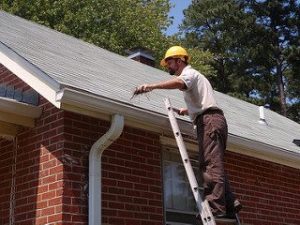 There is little Brits love more than a good home renovation. This is evident in statistics released by Zopa following a survey of over 1200 people who’ve qualified for home improvement loans. One of the biggest findings is that most Brits renovate so that they can create their dream home. The intention is not to increase the value of their homes so that they can sell. The vast majority of renovators opt to use a contractor and subcontractors.
There is little Brits love more than a good home renovation. This is evident in statistics released by Zopa following a survey of over 1200 people who’ve qualified for home improvement loans. One of the biggest findings is that most Brits renovate so that they can create their dream home. The intention is not to increase the value of their homes so that they can sell. The vast majority of renovators opt to use a contractor and subcontractors.
By the numbers
- 67% of renovators don’t plan to sell for at least another five years
- 34% chose to revamp their kitchens
- 73% hired professionals to complete the project
- 45% used skilled professionals for the entire project
- 13% did all the work themselves
- 13% roped in family and friends to help complete the project
So the question is:
How do you choose a contractor?
The first thing you need to do is ask friends and acquaintances for recommendations. Social media allows you to go beyond your usual social circle so you can get a wider range of opinions. You could also go through the classifieds (online or print) and choose some names that appeal to you. Either way, you will need to get references from at least three contractors on your list.
Contractors should provide references happily; if not, then they may be trying to hide something, which is not a good sign. The references should be relevant to your project, so if you are getting your kitchen redone, they shouldn’t give you references for converting a loft or building a deck and gazebo.
They should also provide contact details for their previous clients, and there are two reasons you should definitely contact them:
- References aren’t always genuine
- You can ask questions like: Would you hire the contractor for another job? Was the contractor conscientious about clean up? Were they open to communication, especially about problems? Were they flexible enough to solve problems on the fly? Was the job completed on deadline and within the budget?
Make sure the contractor (and subcontractors) are properly accredited and licensed. For example, they are a registered gas engineer or registered electrician. Membership to professional associations or approved trader schemes is also a good sign. Most associations and schemes have websites that allow you to find accredited members so that you can verify the claim.
Don’t be afraid to verify other details, including a permanent business address and phone number (not just a mobile number), proof of qualifications, and proof of insurance.
You should also interview the contractors on your shortlist. A face-to-face meeting is one the best ways to get the measure of a professional, plus you can bring your gut into play. If your gut feels uneasy, take the hint and hire someone else. After all, you will be spending a lot of time with this person and they will be in your home – your personal safety space and sanctuary. You don’t want to be constantly butting heads or looking over your shoulder.
When it comes to the interview:
 Preparation is essential. Go to the meeting with a written description of everything you want done, as well as a list of questions you need to ask during the course of the interview (you can get ideas of appropriate questions on Trustmark).
Preparation is essential. Go to the meeting with a written description of everything you want done, as well as a list of questions you need to ask during the course of the interview (you can get ideas of appropriate questions on Trustmark).
During the meeting, write down everything that the contractor says they can do – you can even record the meeting (with permission), so you don’t forget anything and can transcribe the meeting later. Ask them for a written quote. They might be able to provide you with a verbal quote at the meeting, but really it would be an estimate, as it’s necessary to sit down and seriously consider materials, scheduling, and pricing, and that can’t happen during the meeting.
The quote
Three is the magic number in the contractor hunt. Get written quotes from at least 3 different contractors. Make sure that they are quotes and not estimates. Contractors can’t charge you more than the quoted price (with exceptions, like when you’ve given permission for extra work to be done), but they can change the price on an estimate. Be very clear about what you want so that the contractors can be as accurate as possible.
Remember that you enter a binding agreement when you accept a quote. It’s essential you’re happy with everything in the agreement. If not, talk to the contractor and see if you can come up with a mutually beneficial arrangement.
The quote should include:
- A fixed total price. You don’t want to get a daily rate because unscrupulous contractors can spin out the days, and you could end up paying an absolute fortune. Daily rates need a time estimation (how many days), well how many hours constitute a work day.
- A breakdown of all the work required
- A breakdown of all the materials needed
- Costing for each part of the job and the material needed for each part of the job
- Does the quote include VAT
- Conditions under which the price can change
Insurance
It is very important that contractors have the proper insurance, so don’t agree to a quote unless you have seen proof of their insurance. Insurance policies contractors should have include:
- Public liability insurance
- Employers’ liability insurance
- Contractors’ all-risk cover
- Insurance-backed warranties or guarantees
If the contractor doesn’t have insurance, you should consider taking out the insurance policies required to protect yourself against all manner of risks.
Don’t forget to inform your home insurance provider about the work being done, as you might have to increase your cover for the duration of the project.
 You’ve chosen a contractor, now what?
You’ve chosen a contractor, now what?
Now you need a written contract. A written contract is more for your peace of mind than the contractors. It stipulates exactly what work is required, the duration of the projects, inclusions and exclusions, the use of subcontractors, and who is responsible for which admin tasks. A written contract gives you a legal footing in case the contractor doesn’t keep up his end.
The contract should also include:
- Start and finish dates
- What happens in the case of delays
- Rubbish removal and tidying up
- How materials and equipment are purchased
- The form of payment, for example, deposit, payment in stages, and final payment.
Talking about payment
According to Citizens Advice, you should pay by card and not cash. Paying by card may allow you to get your money back if the contractor shirks or skips work. This is because banks offer a little-known chargeback scheme. Talk to a manager for details. A section 75 claim is another option if you need to get your money back.
Paying in stages is recommended because problems can be fixed immediately before payment allows contractors to go on to the next stage.
It’s a good idea to buy materials yourself so that they belong to you and you’re not vulnerable to theft if you have chosen an unscrupulous contractor. This way, you can also avoid paying a deposit. If the project is so extensive that only an expert can buy materials (or discounts are contingent upon contractors’ or builders’ purchasing the materials), then try to keep the amount to 25% of the total cost quoted – 10% is better.
Make sure you get receipts for everything.
Some people like to act as their own contractor, which means they oversee everything and hire subcontractors to do all the work. This is great if the project is relatively small and manageable or if they have experience working in construction or managing complicated projects.
For the inexperienced among us, contractors are the way to go – just make sure you take care to choose someone with a reputation for quality and reliability.
 Many first-time homeowners aren’t prepared for the work required to make their houses well-maintained and habitable. They also don’t realise that home maintenance is not just a matter of aesthetics or practicality. It’s also necessary to ensure the validity of home insurance claims in the event of some sort of disaster.
Many first-time homeowners aren’t prepared for the work required to make their houses well-maintained and habitable. They also don’t realise that home maintenance is not just a matter of aesthetics or practicality. It’s also necessary to ensure the validity of home insurance claims in the event of some sort of disaster.
According to statistics from the Association of British Insurers (ABI) and the Office for National Statistics (ONS), only 79% of home insurance claims were approved during 2013 – 2014, and one of the biggest reasons for denying claims was lack of or poor home maintenance. So, while it might seem like a schlep to get the ladder, set it up, find a bucket, hunt for gloves, and climb up to clean your gutters, it’s really one of the best things you can do for your bank account. If you don’t and choose to watch footie on the TV instead, then come next rainy season, you could be looking at thousands of pounds of water damage that your insurance won’t pay for.
Exterior home maintenance tips
It’s easy to overlook certain exterior features of your home for the simple reason that people tend not to look up. If it’s not eye level, we don’t see it. So you need to make a point of inspecting your exterior walls all the way to the top, as well as fascia, gutters, tiles, nails, bolts, and everything related to your chimney.
For example:
Render on your exterior walls
Many houses have render on exterior walls, either to give it a smooth finish or a rustic roughcast. Render can deteriorate over time, so you need to check for damp, cracks, peeling or sections where render has fallen off entirely. If you see deterioration, it’s a good idea to contact an expert for advice on how to fix it.
Fascia
Fascia boards are usually made of wood or sheet metal. You need to check for rot, damp and rust, and check the joins to make sure they aren’t splitting or separating.
Roof and chimney
Inspect your roof for displaced, damaged and missing tiles, as well as rusty nails or bolts and worn sealant. It’s fairly easy to repair minor damage yourself, but if the damage looks complicated or on the very of being extensive, call a professional roofer.
Chimneys are often overlooked – aside from an annual sweep. You need to check the exterior of the chimney for damp, deteriorating render, lead work and crumbling mortar. If there is damp on the ceiling of the room below the chimney, they may be gaps in the mortar that could make the chimney unstable. Unstable chimneys are likely to fall down, and when they do, they cause a lot of expensive damage.
Window frames and doorframes
We also forget to look at window frames and doorframes from the outside. It’s important that you check for rot and damp and give them an annual coat of paint or varnish. It’s important from an insulation and security perspective.
How do insurance companies make decisions regarding claims?
 We look to Ombudsman News for the answer.
We look to Ombudsman News for the answer.
Insurers look for the causation of a situation, causation is determined in two ways:
- “But for” test
- Common sense
In the “but for” test, insurers ask: But for occurrence X, would Y have resulted? The idea is to determine the dominant or effective cause of the damage.
The “but for” test can also be used to answer: In what circumstances did the damage take place? Or: What has the occasion of the damage?
We’re going to take the example Ombudsman News provides.
A claim for roof damage as a result of a storm – the insurer claims poor maintenance led to the damage. Weather reports confirm the storm and high winds; the loss adjustor’s report confirms poor home maintenance. The ombudsman has to decide which was the primary cause of the damage.
Using the “but for” test, we ask: But for the storm, would the roof have been damaged?
It could very well be argued that the answer is no, and the storm caused the damage, so the claim must be paid. However, according to the loss adjustor’s report, the roof was so poorly maintained that it would only have taken moderate wind to blow them off. Based on this evidence – and using common sense – poor maintenance is judged to be the dominant cause (the storm was merely the occasion during which the damage occurred), so the claim is denied.
One last tip
Always, always, always read your home insurance policy wording, including terms, conditions, exclusions and restrictions. Most home insurance policies specifically state home maintenance is required to validate the policy.
 What do you want to do with your retirement years? Do you want to indulge your love for travel? Do you want to live close to your children and grandchildren? Would you prefer a quiet life in the country? Whatever you want to do, you have to make one important decision: Are you going to sell your home and buy a smaller, more manageable property, or are you going to sell your home and rent a smaller, more manageable property?
What do you want to do with your retirement years? Do you want to indulge your love for travel? Do you want to live close to your children and grandchildren? Would you prefer a quiet life in the country? Whatever you want to do, you have to make one important decision: Are you going to sell your home and buy a smaller, more manageable property, or are you going to sell your home and rent a smaller, more manageable property?
According to several studies, the number of retirees renting property is increasing. There are pros and cons to this trend, which depend on the reason and the attitude of the retirees concerned.
The numbers
In August 2013, Prudential found that around 33% of renters were over 41 years old, an increase from 20% in 2011. Forty-two per cent of retired tenants were former homeowners and the reasons for renting included:
- Paying debt (40%)
- Paying divorce/separation costs (19%)
- Boosting retirement income (8%)
- Helping children financially
The majority of retirees renting had never owned a home before (58%), and 75% had no plans to buy property in the future.
Current figures from the National Landlords Association (NLA) reveal that the number of retired private renters has grown by 13% since 2012. It works out to an increase of more than 200,000 people. Unfortunately, while the number of retiree renters has increased, the number of landlords catering to the market has decreased by 10% since 2012.
Why? Because landlords would rather rent to tenants with a steady (employment-related) income, as they are perceived as less risky.
According to Carolyn Uphill, chairperson of the NLA, retirees are considered risky due to uncertainty regarding pension provisions. High-cost (in-demand) areas are most likely to be out of bounds for retirees. So many people won’t be able to retire where they live, especially if they live near transport links and amenities. The upshot, according to Uphill, is that instead of living out their lives in their comfort zones, many retirees will have to move to new communities where they don’t know anyone.
 The most popular areas for retired renters, according to the NLA’s study, include:
The most popular areas for retired renters, according to the NLA’s study, include:
- The South East: 17%
- North West: 15%
- West Midlands: 8%
- North East: 4%
- East Midlands: 4%
- London: 3%
The implications of renting in retirement
There are several positive aspects to renting in retirement. Renting releases capital which you can use to settle debt and bulk up retirement savings. You can also give your children and grandchildren a financial boost. Another great benefit is that you no longer have to worry about property maintenance. If there are any problems, all you have to do is call your landlord.
If you do your research properly, you’ll find out what your rent covers and can work out any other living expenses, so you know exactly what your disposable income will be. Don’t forget to include renewal increases and renewal fees in your calculations. This gives you an idea of what renting will cost in 10 years’ time.
However, you must realise that even if you find a great property with a great landlord, your lease may not be renewed, and you might have to move fairly frequently. Considering that moving home is one of the most stressful life events and that moving is an expensive exercise, you have to think about how you’ll cope with your dotage.
Of course, you don’t have to go into the private sector. You can rent in a retirement community, in which case you have the added security of basic medical care on-site (perhaps even advanced nursing care, depending on the community). You can also participate in a range of activities provided or organised by the centre and enjoy good company.
For a lot of retired people, renting is not a lifestyle choice – they simply have no other option. But it doesn’t matter what the reasons behind renting in retirement, if you make good decisions about where you live, you check out your landlords thoroughly, and you plan for the future, you can rent in peace.
Buying a home is the dream, but actually having a home is an expensive business. Every month we dutifully pay for home insurance so when a disaster happens, we can claim and replace household items. Unfortunately, claiming from your insurance just once will have an effect on any future claims, no matter the reason for your claim. That’s right, your claims history can make you a greater risk for future claims, which results in higher premiums. This is frustrating for homeowners who are penalised twice through no fault of their own.
That’s not to say you should be afraid of claiming; after all, that’s why we have insurance in the first place. Bear these following points in mind and save yourself a nasty surprise the next time you renew your policies.
Size doesn’t matter
Firstly, the size of the claim is not an issue. Bigger claims are not necessarily more expensive for insurers than smaller claims, as most of the costs are admin-related. All claims bear the same admin costs regardless of the amount claimed.
Your insurance premiums are based on your claims history. So if have claimed before you are considered more likely to claim than someone who hasn’t ever claimed.
You’re not bound for life
Your claims history is only one part of your risk profile. Your insurance score is based on a number of things, including your claims history, credit scores and driving record. Insurers calculate your insurance using these and other factors. The calculations differ from company to company. This is why it pays to compare insurance premiums, so you can find one that best suits your needs and claims history.
Even though you have to declare past claims, it’s worthwhile comparing insurance quotes against the anticipated premium increase. Traditional thinking says that staying with one insurer will lead to loyalty benefits, but the contrary is true. Insurers are more likely to offer better deals to attract new customers rather than focus on existing customers.
However, there’s no reason you can’t be a new customer more than once! If you find that an opening offer beats the renewal price, don’t be afraid to sever ties and move on.
Honesty is the best policy
It is crucial that you are honest, open and upfront about your claims history. If you are found to have misled or omitted any important information, your insurance policy could be invalidated and you will effectively not be insured. What’s more, you may only find out about this at a time when you really need it, so rather don’t take any chances.
One way you can balance honesty and the hard reality of your claims history is by taking preventative measures. If, for example, your residential area is prone to floods and your previous claim was as a result flood damage, be sure to keep an eye on communications and alerts from your local council regarding impending weather conditions. Or, if your previous claim related to a burglary, update your security system to deal with the weakness that led to the break-in. Such proactive measures will go a long way with your insurers and their considerations of your premiums.
In a nutshell, we have insurance for a reason so if you need to, claim from it. So, as long as your claims are legitimate and you don’t claim every other week, you shouldn’t be afraid of claiming. Bear in mind, though, that this will impact your future insurance premiums.
 Are you thinking about renovating your home, even doing something relatively simple like remodelling your kitchen cupboards or making your bathroom en suite? Whatever renovations are on the cards, you need to take care of one detail first. Inform your home insurance provider of your intentions. It’s essential that your home insurer knows what your plans are for two reasons:
Are you thinking about renovating your home, even doing something relatively simple like remodelling your kitchen cupboards or making your bathroom en suite? Whatever renovations are on the cards, you need to take care of one detail first. Inform your home insurance provider of your intentions. It’s essential that your home insurer knows what your plans are for two reasons:
- To temporarily update your policy with optional add-ons to cover the renovation process and associated risks.
- The changes may affect your policy in terms of rebuild value and may mitigate (or increase) vulnerability to certain risks.
If you are planning major extensions or alterations, you may actually need to purchase a dedicated renovations insurance policy. The policy needs to be in place before work begins.
Some standard home insurance providers offer renovation insurance. If your insurer doesn’t offer renovation insurance, they may be able to point you in the direction of non-standard home insurance providers.
What to look for in non-standard home insurance policies
Dedicated renovation insurance policies cover the structure, as well as building materials stored on site. They also vacant properties during renovations. Some policies include hired tools and equipment, which is important if you are tackling the project on your own.
Compare policies carefully before you buy because some are more limited in scope than others. For example, if you’ve got a major project going and extensions are going to come close to your boundary wall, you will need liability cover for damage to your neighbour’s property – and not all home renovation insurers include liability cover as standard.
The policy also needs to take into account whether you are using a contractor (who will have insurance to cover certain risks) or whether you are doing most of the work on your own.

Cover should include:
- Existing buildings and contract works (Contractor’s all-risk policy)
- Vandalism, fire, and theft if the property is unoccupied
- Newly renovated work and conversions against fire, storm, and flood damage, etc.
- Increased public liability cover
- DIY projects may need employer’s liability cover for hiring contractors or even getting friends to help out on their weekends
- Cover for equipment and materials on site
- Cover for personal accidents
- Legal expenses
You can convert some renovation insurance policies to standard home insurance policies when work is finished.
Other insurance options
According to BuildSafe, there are two other insurance policies that home renovators need to consider:
Latent Defect Insurance (Structural Warranty)
The policy covers residential homes for 10 years against latent defects in the build and design of the home. According to the Council of Mortgage Lenders, the warranty doesn’t just apply to new builds but also to conversions, extensions and renovations.
Non-Negligent JCT 21.2.1 Insurance
This policy provides cover against damage to neighbouring properties during the renovation process. Even though hired contractors will have their own liability insurance, it may not cover this type of damage, so homeowners need their own liability policy to cover the gap. Non-negligent cover insures against damage caused by subsidence, collapse, vibration, lowering groundwater, etc.
It’s estimated that 300,000 homes are renovated, extended or converted every year, if you are going to join their ranks, it’s your responsibility to ensure that you are properly protected against all conceivable risks associated with the building process. Remember to buy cover before you start renovating your home, not only to ensure that all risks are covered but also to ensure that you get the best rates possible.
 Listed buildings are a treasure and often have hundreds of years of fascinating history lending to their character. Life is complicated for listed property owners when they want to buy insurance. This is thanks to a tangle of red tape that average homeowners never consider.
Listed buildings are a treasure and often have hundreds of years of fascinating history lending to their character. Life is complicated for listed property owners when they want to buy insurance. This is thanks to a tangle of red tape that average homeowners never consider.
What insurance do listed buildings need?
Listed buildings require non-standard insurance, and not all insurance companies offer sufficient cover to protect listed properties. Fortunately, listed buildings have dedicated home insurance policies. However, you need to find the cover that suits your property’s unique characteristics and risks.
Definition of ‘listed property’
According to British Listed Buildings, a listed building “has been placed on the Statutory List of Buildings of Special Architectural or Historic Interest”. Currently, the UK has nearly 500,000 listed buildings. Listed buildings can be any structure, including bridges and memorials that still have survived in much of their original state. Very old buildings (built before 1700) are all listed, and most structures built between 1700 and 1840 are automatically listed. Only younger buildings (built after 1945) of exceptional importance are listed. The youngest a building or structure can be to make the list is 30 years old.
England and Wales use the same classification criteria to grade listed buildings:
- Grade 1: Buildings of exceptional interest, perhaps of international importance. Currently, only 25% of listed buildings have a Grade 1 listing.
- Grade 2: Buildings of particular importance with ‘more than’ special interest. Currently, 5.5% of listed buildings have a Grade 2 listing.
- Grade 3: Buildings of national importance and special interest. Currently, 92% of listed buildings have a Grade 3 listing. The majority of private residential listed buildings are Grade 3.
Scotland uses a classification system (A, B, C) that is similar to the system in England and Wales.
Anyone who owns a listed property needs to follow a very specific set of rules to retain its integrity. For instance, owners need special permission from local planning authorities to extend, alter or demolish parts of or the entire building. Local planning authorities often consult central government agencies before approving plans unconditionally, providing conditional approval or declining the application outright. Alterations done without approval can result in criminal charges.
Repairs, on the other hand, are mandatory, and any owner who fails to keep up with repairs or who allows the building to fall further into disrepair may face criminal charges.
Repairs, alterations, and extensions are complicated by the special materials required to maintain the structure. These materials are almost always more expensive than commercial materials commonly used. And this helps to drive up insurance costs.
Insuring listed property
Note that listed and non-listed older buildings generally fall into the listed buildings insurance category. This is because the techniques and materials used in the construction (and repair), and are more difficult to come by today and so are more expensive.
Listed buildings also come with inherent risks, such as damp, decay, and eroding brickwork. Their structure may also put them at greater risk of changing weather conditions and extreme weather, including storms and floods. A listed property may have stood up to weather for a hundred years, but all it takes is one exceptional storm to bring the roof (or walls) down.
In an article for the Telegraph, insurance intermediary company William Thatch said that as many as 80 per cent of period homes risk losing money if their properties are damaged or destroyed. Listed buildings face greater risk as only specialist (expensive) craftsmen can do the work. This is stipulated when you buy a listed building ownership.
Specialist insurance
It may seem unnecessarily expensive, but owners should consider getting unlimited cover with no maximum payout. Or they should agree to a higher excess payment for greater cover. Owners should not forget about contents insurance. Often the furnishings and décor complement the building, which includes antique or bespoke furniture that is expensive to replace.
Edward Powell of William Thatch suggests that listed property owners buy specialist insurance to cover the work required to restore the property to its original condition. If they don’t can face criminal charges. Not being able to afford the cost of the work won’t get you off the hook.
Living in a listed property is a privilege, and owners should treat their homes with respect. Routine maintenance and regular inspections are a matter, of course, to keep the property well preserved. It also saves you money in the long run.